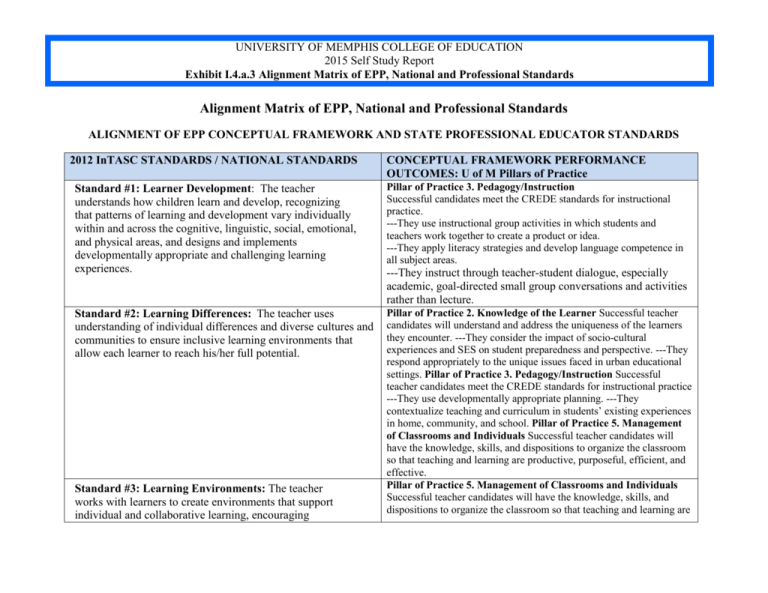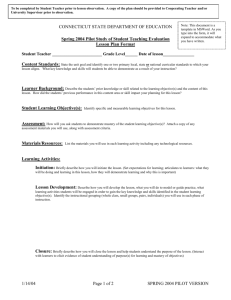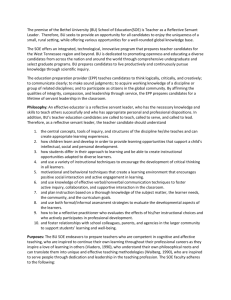Alignment Matrix of Unit, State, and Professional Standards
advertisement

UNIVERSITY OF MEMPHIS COLLEGE OF EDUCATION 2015 Self Study Report Exhibit I.4.a.3 Alignment Matrix of EPP, National and Professional Standards Alignment Matrix of EPP, National and Professional Standards ALIGNMENT OF EPP CONCEPTUAL FRAMEWORK AND STATE PROFESSIONAL EDUCATOR STANDARDS 2012 InTASC STANDARDS / NATIONAL STANDARDS CONCEPTUAL FRAMEWORK PERFORMANCE OUTCOMES: U of M Pillars of Practice Standard #1: Learner Development: The teacher understands how children learn and develop, recognizing that patterns of learning and development vary individually within and across the cognitive, linguistic, social, emotional, and physical areas, and designs and implements developmentally appropriate and challenging learning experiences. Pillar of Practice 3. Pedagogy/Instruction Successful candidates meet the CREDE standards for instructional practice. ---They use instructional group activities in which students and teachers work together to create a product or idea. ---They apply literacy strategies and develop language competence in all subject areas. Standard #2: Learning Differences: The teacher uses understanding of individual differences and diverse cultures and communities to ensure inclusive learning environments that allow each learner to reach his/her full potential. Pillar of Practice 2. Knowledge of the Learner Successful teacher candidates will understand and address the uniqueness of the learners they encounter. ---They consider the impact of socio-cultural experiences and SES on student preparedness and perspective. ---They respond appropriately to the unique issues faced in urban educational settings. Pillar of Practice 3. Pedagogy/Instruction Successful teacher candidates meet the CREDE standards for instructional practice ---They use developmentally appropriate planning. ---They contextualize teaching and curriculum in students’ existing experiences in home, community, and school. Pillar of Practice 5. Management of Classrooms and Individuals Successful teacher candidates will have the knowledge, skills, and dispositions to organize the classroom so that teaching and learning are productive, purposeful, efficient, and effective. Pillar of Practice 5. Management of Classrooms and Individuals Successful teacher candidates will have the knowledge, skills, and dispositions to organize the classroom so that teaching and learning are Standard #3: Learning Environments: The teacher works with learners to create environments that support individual and collaborative learning, encouraging ---They instruct through teacher-student dialogue, especially academic, goal-directed small group conversations and activities rather than lecture. UNIVERSITY OF MEMPHIS COLLEGE OF EDUCATION 2015 Self Study Report Exhibit I.4.a.3 Alignment Matrix of EPP, National and Professional Standards 2012 InTASC STANDARDS / NATIONAL STANDARDS positive social interaction, active engagement in learning, and self-motivation. Standard #4: Content Knowledge: The teacher understands the central concepts, tools of inquiry, and structures of the discipline(s) he or she teaches and creates learning experiences that make these aspects of the discipline accessible and meaningful for learners. Standard #5: Innovative Applications of Content: The teacher understands how to connect concepts and use differing perspectives to engage learners in critical/creative thinking and collaborative problem solving related to authentic local and global issues. Standard #6: Assessment: The teacher understands and uses multiple methods of assessment to engage learners in their own growth, to document learner progress, and to guide the teacher’s ongoing planning and instruction. CONCEPTUAL FRAMEWORK PERFORMANCE OUTCOMES: U of M Pillars of Practice productive, purposeful, efficient, and effective. ---They create a safe learning environment. ---They manage individual student behavior. --They provide for active engagement in learning experiences. Pillar of Practice 1. Content Knowledge and Skills Successful teacher candidates will understand and be able to use and address the in-depth information and skills within their discipline Pillar of Practice 2. Knowledge of the Learner Successful teacher candidates will understand and address the uniqueness of the learners they encounter. ---They design instruction and employ learning technologies that address different and specific developmental learning needs. ---They adapt instruction to meet the needs of individual learners. ---They consider the impact of socio-cultural experiences and SES on student preparedness and perspective. ---They respond appropriately to the unique issues faced in urban educational settings. Pillar of Practice 4. Assessment/Responsive Practice Successful teacher candidates will be able to gather and assess formative and summative evidence of student learning through formal, informal, individual, and group modes. ---They select appropriate assessment tools. ---They use assessment tools/processes/technologies to gather evidence of student learning during instruction and respond to that evidence immediately by modifying instruction including use of instructional technologies. ---They administer formal assessments. ---They analyze evidence (formal/informal; formative/summative) and use the results of these modes of assessment to monitor and adjust instructional content, strategies, UNIVERSITY OF MEMPHIS COLLEGE OF EDUCATION 2015 Self Study Report Exhibit I.4.a.3 Alignment Matrix of EPP, National and Professional Standards 2012 InTASC STANDARDS / NATIONAL STANDARDS CONCEPTUAL FRAMEWORK PERFORMANCE OUTCOMES: U of M Pillars of Practice resources, and expectations for individuals and groups of students, and to communicate with students and their families about progress and needs. Standard #7: Planning for Instruction: The teacher draws upon knowledge of content areas, cross-disciplinary skills, learners, the community, and pedagogy to plan instruction that supports every student in meeting rigorous learning goals. Pillar of Practice 3. Pedagogy/Instruction Successful teacher candidates meet the CREDE standards for instructional practice --They use developmentally appropriate planning. ---They use effective and comprehensive lesson planning processes/structures to ensure effective instructional practice. ---They create and/or use curriculum tools to plan instruction. Pillar of Practice 1. Content Knowledge and Skills Successful teacher candidates understand and are able to use and address the in-depth information and skills with the academic disciplines. Pillar of Practice 3. Pedagogy/Instruction Successful teacher candidates meet the CREDE standards for instructional practice --They use instructional group activities in which students and teachers work together to create a product or idea. ---They maintain challenging standards for student performance and design activities to advance understanding to more complex levels. ---They instruct through teacher-student dialogue, especially academic, goal-directed small group conversations and activities rather than lecture. ---They apply literacy strategies and develop language competence in all subject areas. Pillar of Practice 4 – Assessment and Responsive Practice Successful teacher candidates are able to gather formative and summative evidence of student learning, and use that evidence to monitor and adjust instructional content, strategies, and resources as needed for individual and groups of students Pillar of Practice 2 – Knowledge of Learner Successful teacher candidates understand and address the uniqueness of the learners they encounter. Pillar of Practice 4. Assessment/Responsive Practice Successful teacher candidates will be able to gather and assess Standard #8: Instructional Strategies: The teacher understands and uses a variety of instructional strategies to encourage learners to develop deep understanding of content areas and their connections, and to build skills to access and appropriately apply information. Standard #9: Reflection and Continuous Growth: The teacher is a reflective practitioner who uses evidence to UNIVERSITY OF MEMPHIS COLLEGE OF EDUCATION 2015 Self Study Report Exhibit I.4.a.3 Alignment Matrix of EPP, National and Professional Standards 2012 InTASC STANDARDS / NATIONAL STANDARDS continually evaluate his/her practice, particularly the effects of his/her choices and actions on others (students, families, and other professionals in the learning community), and adapts practice to meet the needs of each learner. CONCEPTUAL FRAMEWORK PERFORMANCE OUTCOMES: U of M Pillars of Practice formative and summative evidence of student learning through formal, informal, individual, and group modes. ---They use assessment tools/processes/technologies to gather evidence of student learning during instruction and respond to that evidence immediately by modifying instruction including use of instructional technologies. ---They analyze evidence (formal/informal; formative/summative) and use the results of these modes of assessment to monitor and adjust instructional content, strategies, resources, and expectations for individuals and groups of students, and to communicate with students and their families about progress and needs. Pillar of Practice 6. Personal and Professional Growth and Development Successful teacher candidates are reflective about their work and their emerging practice, and affirmatively seek out opportunities to participate in, learn from, and contribute to wider communities of professional educators. Standard #10: Collaboration: The teacher collaborates with students, families, colleagues, other professionals, and community members to share responsibility for student growth and development, learning, and well-being. Pillar of Practice 2. Knowledge of the Learner Successful teacher candidates will understand and address the uniqueness of the learners they encounter. ---They communicate effectively with students and their parents/guardians. See SPA alignment on the next page. UNIVERSITY OF MEMPHIS COLLEGE OF EDUCATION 2015 Self Study Report Exhibit I.4.a.3 Alignment Matrix of EPP, National and Professional Standards InTASC (2012), TENNESSEE AND PROFESSIONAL EDUCATOR STANDARDS ALIGNMENT CHART 2012 InTASC STANDARDS / NATIONAL STANDARDS ECED ELED SPED NAEYC ACEI Standard #1: Learner Development Standard #2: Learning Differences 1, 4 Standard #3: Learning Environments Standard #4: Content Knowledge Standard #5: Innovative Applications of Content Standard #6: Assessment Standard #7: Planning for Instruction Standard #8: Instructional Strategies Standard #9: Reflection & Continuous Growth Standard #10: Collaboration Art Music English CEC Physical Education NASPE Math Science NCTE Foreign Language ACTFL NCTM NSTA Social Studies NCSS NAEA NCTM 3.5 2 3 2 1b 2 1 3 3 6 1, 4 3.2 1 5 4, 2 3 4 1-5 3, 4 2, 3 3 1, 2 3.4 2 1, 2 4 2c 4 1 3, 4 3 5 4b, c, d 1 3 1 1 1a 3 1-5 1 1 1 1, 4 1 1 2 4 -- 4 1-5 3, 4 2 2 3 4 5 2 4 2d 4 5, 2 3, 5 3, 5 8 2, 4 3.1 4 2 4 2a 4 3 2 2 7 1, 4 3.3 4 2 4 2b 4 1 3 2 4 5 5.2 6 6 5 4a, 5a-b 2 2 6 6 9 2, 5 5.1 7 2 5 4b 4 5 6 6 10








